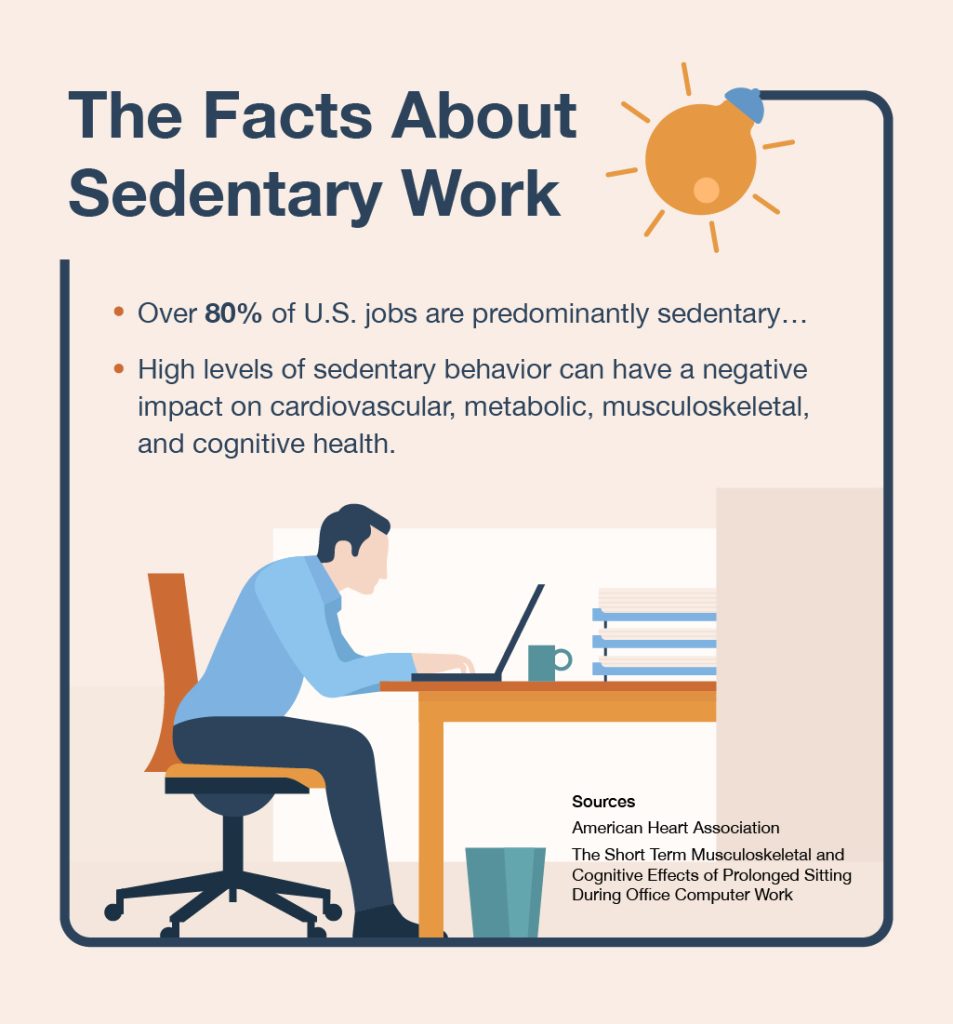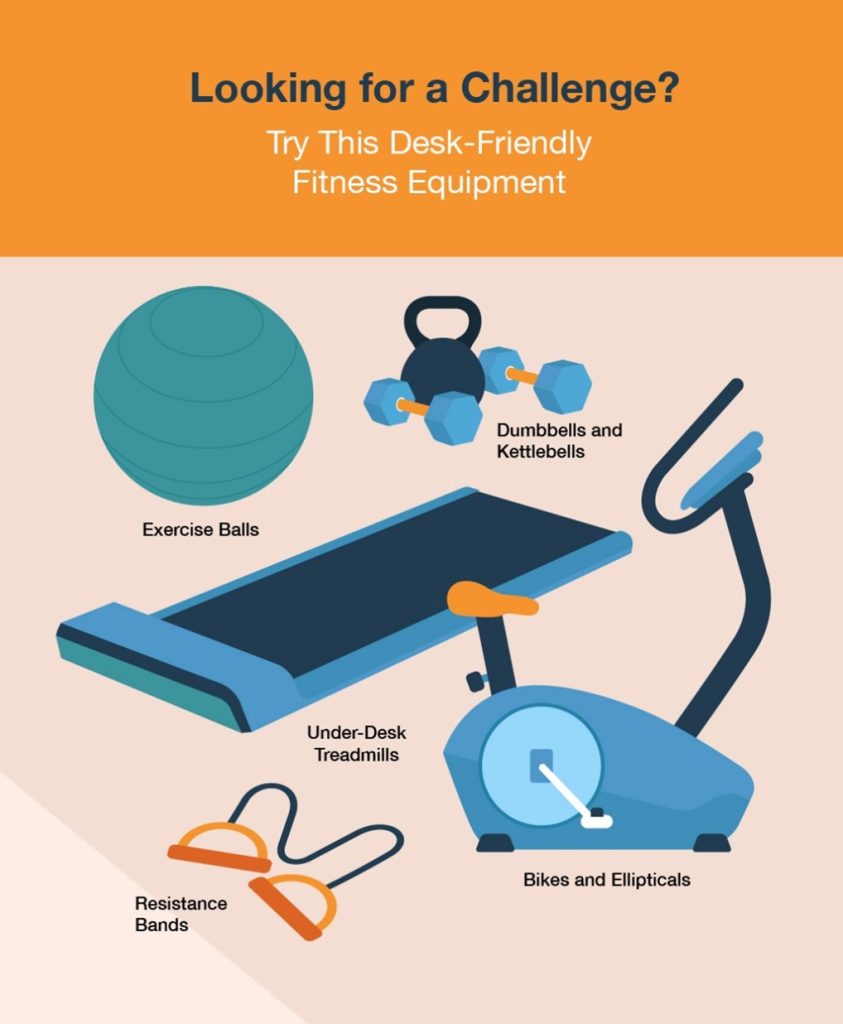There’s no denying that exercise is good for you. But given the fact that over 80 percent of U.S. jobs are predominantly sedentary, it’s little wonder that many employees find it difficult to carve out time for physical activity. Spending 40 hours a week in a desk chair (plus a possible seated commute) makes finding time to get up and get moving a real challenge.
Challenging or not, though, research has shown that making time to move is vitally important; high levels of sedentary behavior—like sitting in your chair at work all day—can have a negative impact on cardiovascular, metabolic, musculoskeletal, and even cognitive health.
If you’re sitting in your office chair, looking at the clock, and feeling doomed, don’t worry—there’s good news.
Paying attention to the ergonomic fit of your office setup, including the quality and height of your chair, whether your armrests are properly adjusted, how your monitor is positioned, and more, can have a real effect on your level of comfort. So, if you’ve never taken the time to ensure your desk is ergonomically sound, that’s a smart first step.
Additionally, chair exercises to increase strength, flexibility, and mobility can be incredibly helpful. For older adults and people with disabilities or medical conditions, seated exercises can come in handy, too, since a chair provides stability and safety, along with making it easy to take things at a pace that works for each individual.

Seated exercises to try
Ready to get moving—without getting out of your chair? Give the following exercises a try. And be sure to take note of whether you feel any different at the end of a day when you’ve made a point to incorporate them into your routine.
Seated oblique crunches
How to do it: Sit on the edge of your chair with your spine nice and straight, feet flat on the floor a little more than hip-width apart. Place your fingertips behind your head with your elbows to the side, then, as you shift your weight to the left leg, crunch to the right, bringing your right knee toward your elbow. Return to the starting position and repeat on the other side to complete one rep.
Benefits: This exercise can help strengthen your core muscles, including your lower back. At the same time, you might feel a nice stretch to the side that’s not crunching, which indicates you’re working on your flexibility, too.
Seated lean backs
How to do it: Start just as you did for the oblique crunches, on the edge of your seat with your feet flat on the ground around hip-width apart. Cross your arms over your chest, then slowly lean your upper back toward the back of the chair while maintaining a straight spine; don’t let your feet lift off the ground. Allow your upper back to gently touch the backrest, then, with control, return to the starting position to complete one rep.
Benefits: This move also works your core, so be sure to fully engage both your abdominal muscles and back muscles as you return to the starting position to get the most bang for your buck.
Seated alternating toe touches
How to do it: Sit up straight in your chair with your arms raised above your head, fingers to the sky, feet on the floor at shoulder width. As you lower your left hand in front of you and down, raise your right foot up to meet it. Try to tap the inside of your foot, but if you can’t reach, that’s okay—don’t overstretch! You want to maintain a fairly straight spine, even if that means you can’t make contact. Return to the starting position and repeat on the other side to complete one rep.
Benefits: Once again, you’ll work your core and improve flexibility; you might also experience a little muscle burn in your quads as you lift those legs, as well as in your shoulders as you hold them straight in front of you. This one can be tough, so be gentle on yourself and don’t force it.
Seated cross-body punches (with or without a kick)
How to do it: While seated on the edge of your chair, place your feet flat on the ground and close to shoulder-width apart. Then, raise your fists in front of your face, like a boxer. As you twist to the right, extend your left arm in front of you (as if you’re punching, although you can move more slowly if you like), then pull it back. Return to the starting position, and repeat on the other side to complete one rep. If you want to increase the difficulty, add a kick with your opposite leg as you punch. Be careful to leave room between your seat and your desk!
Benefits: You’ll work your core as well as your arms as you punch it out. If you speed this move up, you might even raise your heart rate a bit for an added cardiovascular benefit.
Seated skater
How to do it: Place your feet on the floor, hip-width apart, as you sit on the edge of your chair. With your right foot planted, extend your left leg straight out to the side with toes pointed; at the same time, lean forward with your arms straight and extended, touching your left hand to your planted right foot while your right arm goes out behind you, like a skater. Switch and repeat to complete a rep.
Benefits: You can truly elevate your heart rate with this one if you pick up speed. You’ll still work your core, and because you’re reaching and stretching, you’ll give your flexibility a boost, too.
Chest stretch
How to do it: Sitting toward the front of your chair with a straight spine, gently pull your shoulders back and down with your arms extended down and to the sides. Push your chest forward until you feel a stretch across your chest. Hold for 5 to 10 seconds (and make sure to breathe), return to a neutral spine, and then repeat five times.
Benefits: Your posture will thank you for incorporating this stretch into your day, especially if you tend to hunch over your computer.
Ankle stretch
How to do it: While seated, hold each side of your chair and lift your left foot off the floor, straightening your left leg; keep your right foot on the ground. Point your left toes away from you, then flex your left foot to pull the toes toward you. Repeat with the other leg to complete one rep. Aim for two sets of five reps. Try to maintain good posture and keep your core engaged; no slouching!
Benefits: Not only can this stretch improve your ankle flexibility, but it can also lower your risk for blood clots. And, any time you engage your thigh muscle by raising your leg, you strengthen your quad.
Arm Raises
How to do it: Sitting upright with your arms by your sides, palms facing in front of you, raise both arms out to the side and upwards. If it causes no pain, you can lift them straight above you before lowering them to the starting position to complete one rep. Make sure your shoulders stay down and back; don’t shrug them up toward your ears.
Benefits: This movement builds shoulder strength and should feel like a nice counter stretch after sitting at a computer.

Desk-friendly fitness equipment
Interested in taking your workplace workouts to the next level? If your office permits, there’s plenty of desk-friendly fitness equipment that takes up very little room, such as:
- Dumbbells and kettlebells
Start light so you can complete all your reps! - Exercise balls. You can even sit on one while you work, knocking out some crunches between calls.
- Resistance bands. There’s nothing easier to stash in a desk drawer and very little that can beat a band in terms of how many different ways it can be used.
- Under-desk treadmills, bikes, and ellipticals. These bigger investments can be a little challenging to get used to, but they allow you to keep moving all day long, so you don’t have to miss a beat at work to get in your steps.

Conclusion
Remember, any movement during the day is better than none, so if you’re feeling overwhelmed or don’t know where to begin, start with one move. As you build confidence (and strength), you can add in more exercises, use equipment, and maybe even set timers so you get in several micro-moves throughout the day. Whatever you do, your body will thank you!



